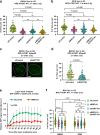Involvement of the splicing factor SART1 in the BRCA1-dependent homologous recombination repair of DNA double-strand breaks
- PMID: 39117746
- PMCID: PMC11310344
- DOI: 10.1038/s41598-024-68926-2
Involvement of the splicing factor SART1 in the BRCA1-dependent homologous recombination repair of DNA double-strand breaks
Abstract
Although previous studies have reported that pre-mRNA splicing factors (SFs) are involved in the repair of DNA double-strand breaks (DSBs) via homologous recombination (HR), their exact role in promoting HR remains poorly understood. Here, we showed that SART1, an SF upregulated in several types of cancer, promotes DSB end resection, an essential first step of HR. The resection-promoting function of SART1 requires phosphorylation at threonine 430 and 695 by ATM/ATR. SART1 is recruited to DSB sites in a manner dependent on transcription and its RS domain. SART1 is epistatic with BRCA1, a major HR factor, in the promotion of resection, especially transcription-associated resection in the G2 phase. SART1 and BRCA1 accumulate at DSB sites in an interdependent manner, and epistatically counteract the resection blockade posed by 53BP1 and RIF1. Furthermore, chromosome analysis demonstrated that SART1 and BRCA1 epistatically suppressed genomic alterations caused by DSB misrepair in the G2 phase. Collectively, these results indicate that SART1 and BRCA1 cooperatively facilitate resection of DSBs arising in transcriptionally active genomic regions in the G2 phase, thereby promoting faithful repair by HR, and suppressing genome instability.
© 2024. The Author(s).
Conflict of interest statement
The authors declare no competing interests.
Figures






References
-
- Hanahan, D. Hallmarks of cancer: new dimensions. Cancer Discov.12, 31–46 (2022). 10.1158/2159-8290.CD-21-1059 - DOI - PubMed
MeSH terms
Substances
LinkOut - more resources
Full Text Sources
Research Materials
Miscellaneous

